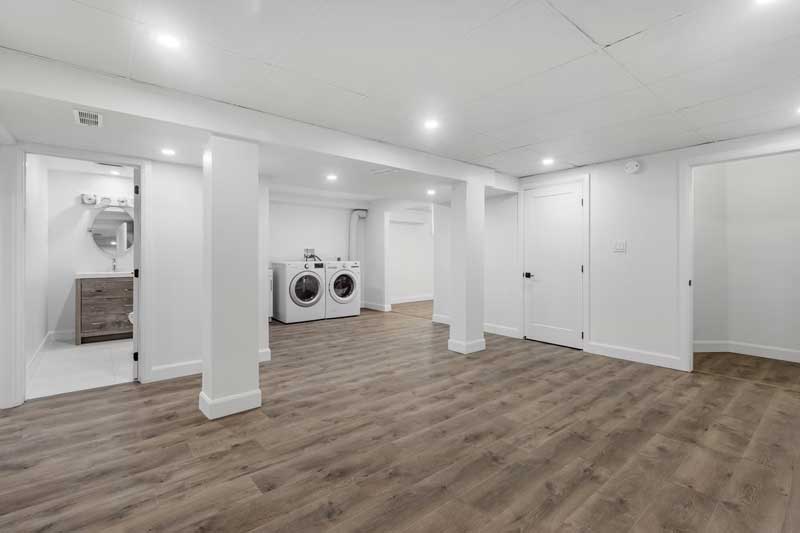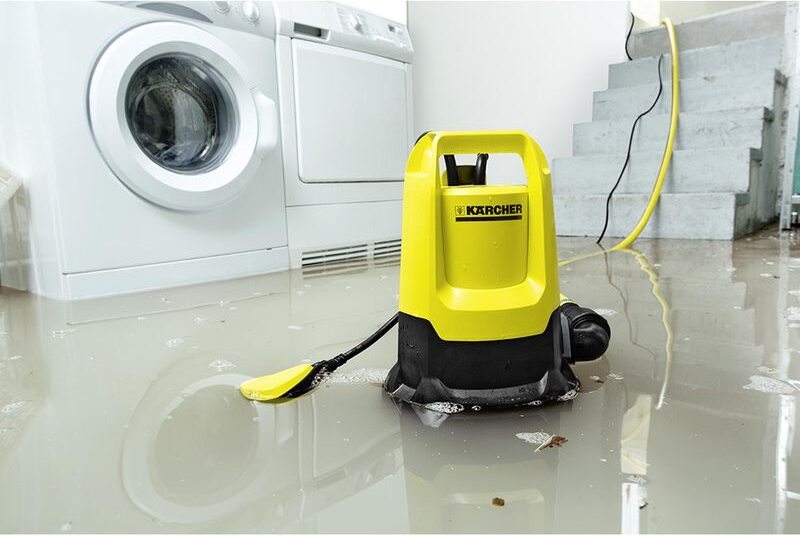If you live in an area with frequent rain, you will know how problematic this can be. In situations without proper precautions, heavy rain leads to significant flooding problems. If you have a basement, these can be susceptible to water infiltration, which is less than favourable.
A flooded basement needs cleaning fast, regardless of how much water has accumulated in the space. It can cause significant health and safety risks, as well as affect the structure of the basement. So, how do you clean up a flooded basement? Find out more below.
Table of contents
- My basement flooded, what do I do?
- What to wear when cleaning a flooded basement
- How to clean a flooded basement
- Saving items from flood damage
- How much does it cost to repair a flooded basement?
My basement flooded, what do I do?
Your priority should first be to turn off all power that connects to the basement. If you’re unsure how to do so, contact a qualified electrician to do so before entering the area and progressing with cleaning up flood water.
Next, you should identify where the flood is coming from. There are many common causes of a flooded basement.
Breakdown:
- Heavy rain or snow quickly melting.
- Water flooding in through cracks in the foundation walls from a storm (including rainwater or groundwater).
- Broken plumbing systems (burst water pipes etc).
- Backed up water from a clogged floor drain or community drainage system.
- Basement windows that have been broken.
If you’re still struggling to identify the cause of the flood, contact a professional plumber for assistance. You can also contact a basement waterproofing service or disaster restoration specialist for advice.

What to wear when cleaning a flooded basement
After you have identified the damage and turned off the power, make sure you protect yourself when you enter the flooded space. Wear PPE (Personal Protective Equipment) to prevent injury or illness, including (not limited to):
- Goggles or protective glasses
- Gloves (plastic or rubber)
- Face mask
- Waterproof rubber boots
A face mask is vital, especially if you need to clear out mould.
The waterproof rubber boots (Wellington boots) are more likely to help protect against the toxic chemicals as you enter and work around the flooded space.
How to clean a flooded basement
Here are some steps to help you clean your flooded basement.
Step one: Remove water from the basement
Mould doesn’t wait for you. Mould can grow within 24 to 48 hours. So, you must remove the water from the basement as quickly.
Here are three efficient ways to remove standing water from a basement:
- Water pumps (pool pump or sump pump).
- Wet/dry vacuum (this method will need multiple trips back and forth to remove the water as you will be emptying the canister to make way for more water removal).
- Mop and bucket.
The method you choose will depend on the level of water you need to remove. Just make sure you remove as much of the water as you can.

Step two: Move damaged items away from the basement
Move any damaged items out of the basement into a well-ventilated area to dry. Allow a minimum of 48 hours for the items to dry.
If any items are still damp after this time, throw them away, as these can be the perfect sources of mould and mildew to grow.
You will also need to remove the following items and discard them as soon as possible because of contamination:
Carpet or flooring
These can absorb water, so they must be removed and disposed of to allow the floor underneath to dry out.
Wet drywall and insulation
These factors can be another source of mould with rapid development, so remove them to prevent growth.
Electricals (Outlets, wires etc.) exposed to the water
Any electricals exposed to the water are extremely dangerous when returned for use. They can result in severe injury or death, so take care and remove them as soon as possible.
Tip: Take pictures for proof to ensure any damages related to your insurance can be covered.
Furniture or general items
Remove any chairs, pillows, plush toys, mattresses, any food and more exposed to the flood water from the area promptly.
Step three: Clean all walls, floors and surfaces
Let your basement dry out for at least several days. Speed up the drying process using fans or opening windows and doors as much as possible. Keep them closed if you use a dehumidifier.
A dehumidifier can help reduce the moisture in the air and prevent the appearance of mould. Emptying of the machine must be completed whenever it fills up and continuously moved around the space to pick up moisture throughout the area.
Once dry, clean the walls, floors and surfaces to remove any dirt or mud left behind by the water. You can do this using ordinary household products. As well as wash down surfaces with a garden hose. Be careful when using bleach, as the fumes are harmful in a poorly ventilated basement. Leave all closed spaces (cupboards, closets etc.) open to ensure the interior dries also.
Water left over from the cleaning can be scooped up using a wet/dry vacuum.
Don’t want to deal with mould or don’t know how to? Contact a professional cleaning service to remove the mould safely.
Saving items from flood damage
With the right care, you can save some items exposed to the flood. Here’s how:
Carpet and flooring
Carpets and floorings not severely affected by the flood should be promptly rinsed and thoroughly cleaned. You should also deodorise carpets or have them professionally cleaned to help reduce the damp smell.
Furniture
Any chairs, tables or similar items not severely affected by the flood should be scrubbed with antibacterial soap or steam cleaned if possible.
Clothing
Any clothing can be machine washed in hot, soapy water and chlorine bleach to disinfect (dilute the bleach in water for safer use on fabric).
The thing to realise from this is that any items without visible signs of contamination can be cleaned and dried. For official guidance regarding the disposal of items after a flood, speak to your local council if you require hazardous waste disposal.
How much does it cost to repair a flooded basement?
The average water removal can be around £1000 to £4000. Pumping out the water can be between £300 to £6500. Not to mention hiring the pump to use, dehumidifier or plumber, which can bump up the total price.
The true cost of water removal and repair will depend on different factors such as the size of the basement, the significance of the damage, the cause of the damage, how easy it is to access the area, the type of water and the company providing the work.
Remember to check whether your insurance covers such damages as this could help you cut down the cost of your removal or repair.

If you want to make sure you have anti-flood systems in place, you can check out our range of flood defence products to ensure you can prevent flooding from happening once again.






















